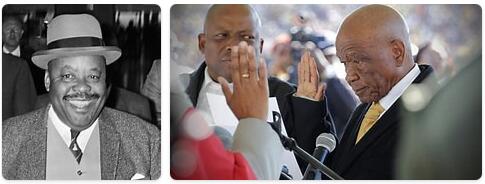
Little is known of the indigenous people of Lesotho, the San. From the 15th century, Bantu-speaking peoples such as Zulu, Sotho, Tswana, Xhosa immigrated to the southern part of Africa. At the beginning of the 19th century, the shepherds of the Nguni and South Sotho fled from the bellicose Zulu from what is now the South African province of Oranjefreistaat to the inhospitable and barren mountainous region of today’s Lesotho.
- COUNTRYAAH: See current national flag of Lesotho. Download high definition image, and learn flag meanings as well as the history of Lesotho flags.
Under the chief Moshoeshoe I (Motlotlehi), the Sotho and Nguni tribes were united to the Basuto people. In the second half of the 19th century, there were conflicts between the South Sotho and the Boers, who moved north in search of more arable land. Chief Moshoeshoe I asked Great Britain for protection from the invading Boers, in 1868 the area became the British Protectorate under the name Basutoland, and three years later it was annexed to the British Cape Colony. The South Sotho’s refusal to recognize the colonial government repeatedly led to violent clashes. In 1884 Basutoland was placed directly under the British crown and was given the right to extensive self-government. When the “South African Union” (from the Cape Colony, Orange Free State, Natal and Transvaal) was founded, the leading tribal chiefs of Basutoland refused to affiliate the country, which was located within the state territory of the Union. At this point in time, there were close economic ties between Basutoland and the South African Union, since many South Sotho had already been deployed to the South African gold and diamond mines as workers from 1870 onwards. Basutoland was officially under the supervision of the British governor-general residing in Cape Town.since as early as 1870 many South Sotho had been deployed as workers in the South African gold and diamond mines. Basutoland was officially under the supervision of the British governor-general residing in Cape Town.since as early as 1870 many South Sotho had been deployed as workers in the South African gold and diamond mines.
In the 1950s, parties were founded in Basutoland: in 1952 the pan-African socialist party “Basotho Congress Party” (BCP) was founded under the leadership of Ntsu Mokhele, five years later the “Marema Tlou Party” split off from it. In 1958 the chief Leabua Jonathan founded the conservative “Basutoland National Party” (BNP). In the first elections in 1960, the BCP won the majority with its goal of independence for the country. In 1965 the party had to hand over the majority to the BNP, its leader Leabua Jonathan became prime minister (until 1986).
In October 1966, Basutoland became independent under the British Commonwealth under the name Lesotho. According to AbbreviationFinder, the constitutional monarchy became the form of government, while the monarch Moshoeshoes II performed predominantly representative tasks. After the 1970 elections there was a coup d’¨¦tat by Leabua Jonathan, who overruled the constitution, imprisoned the leaders of the opposition parties and declared a state of emergency.
In 1973 a radical wing split off from the Basotho Congress Party (BCP) under Ntsu Mokhele, from 1979 the “Lesotho Liberation Army” (LLA) formed from this movement, which tried to overthrow the Jonathan government with its guerrilla activity.
Lesotho was heavily dependent on South Africa economically, but refused to recognize South Africa’s apartheid policy. Relations with the big neighbor deteriorated further when the political leadership of Lesotho established ties to the People’s Republic of China and the Soviet Union in 1983. Leabua Jonathan was removed from the military in 1986, and the political leadership of Lesotho was initially taken over by a military council led by General Justin Lekhanya (until 1991). In 1990 King Moshoeshoe II was deposed by the military government and went into exile in England. His son David Mohato Letsie Bereng Seeiso (Letsie III.) Became the new monarch of Lesotho.
In 1991, General Justin Lekhanya was overthrown, and his successor, Elias Phitsoane Ramaema, took over the presidency of the Military Council and announced a return to parliamentary democracy. The political opposition parties that had been banned until then were re-admitted. In 1993, Lesotho received a new constitution in which the parliamentary monarchy was defined as the state. In the same year, the opposition Basuto Congress Party (BCP) won all 65 parliamentary seats. Its chairman, Ntsu Mokhele, took over the government. A year later, the military attempted a coup to dissolve parliament and override the constitution, but failed with their plans. Moshoeshoe II became regent of Lesotho for a year, after his death in January 1996 King Letsie III rose again to the throne.
- HomoSociety: introduces social conditions of Lesotho, including labor market, insurance, healthcare, gender equality and population information.
In 1997, the controversial head of government Ntsu Mokhele founded his own party (“Lesotho Congress for Democracy”, LCD), 41 of the 64 BCP MPs switched to the new party. In the May 1998 elections, the new Mokhele party managed to secure 78 of the 80 parliamentary seats. Nonetheless, due to a decision by the chiefs in the Senate, BCP chairman Bethuel Pakalitha Mosisili became the new head of government in Lesotho. After persistent civil unrest, King Letsie III asked. South Africa to provide military assistance to source the uprising. South Africa did not withdraw most of its troops from Lesotho until May 1999; Mosisili remained head of government for the time being. The elections planned for 2001 were not held.In the parliamentary elections in May 2002, as in the elections in February 2007, the LCD again became the strongest force. The May 2012 elections resulted in the first coalition government under Thomas Thabane (All Basotho Convention, ABC).
The high mortality rate from AIDS leads to considerable economic losses and contributes significantly to the breakdown of traditional structures and the worsening of the social situation in the country.
